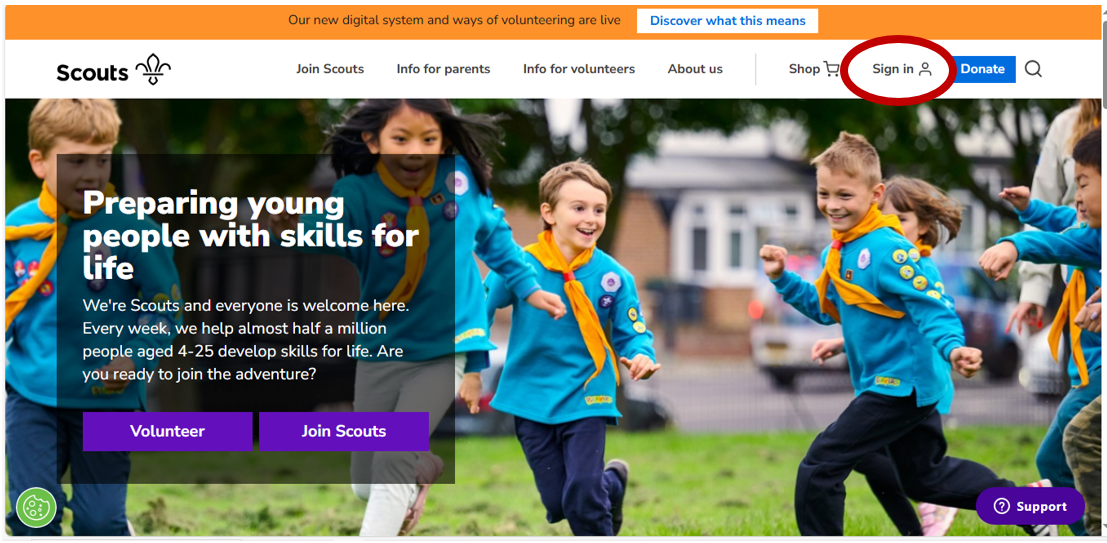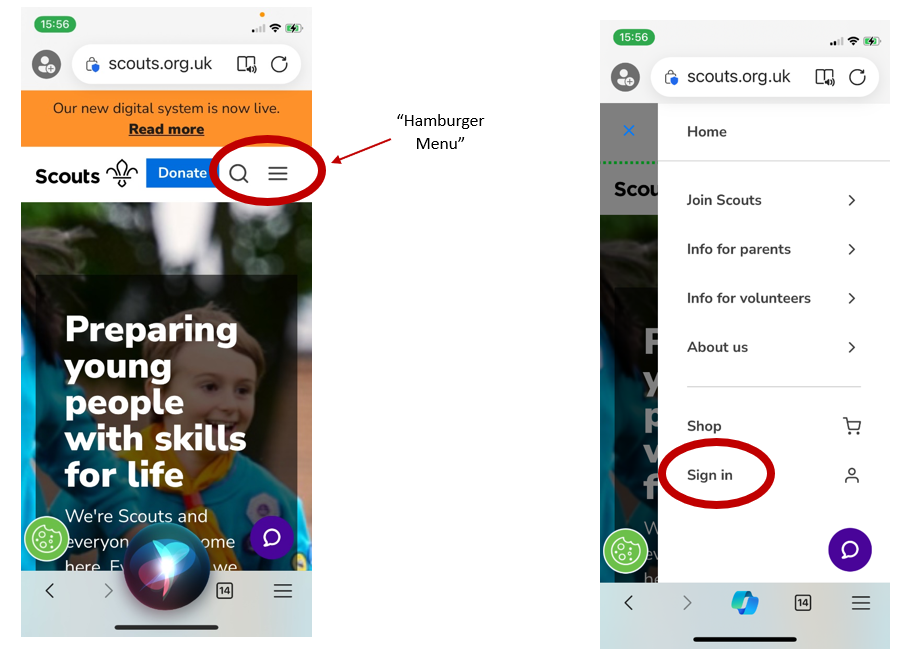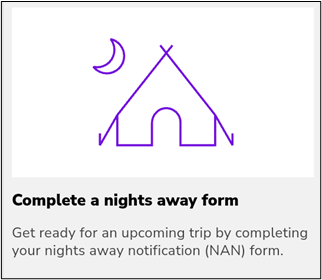Nights Away
Form NAN Submission & Checklist
Nights Away - Form NAN Submission & Checklist
1. Introduction
1.1 A Nights Away Notification is submitted by the Permit Holder or Event Organiser to seek APPROVAL for a Nights Away Event to take place; see P.O.R. 9.1.2.
1.2 The Event Leader (who may also be the Permit Holder) must submit a Nights Away Application and related Risk Assessment online, for each group and each event for which they are responsible., Nights Away Events range from sleepovers in your Scout Hall to the most challenging survival camps and expeditions. Exclusively Adult Groups (e.g. a Scout Group Leadership Team) do not need to submit a Nights Away application, but are required to notify the District Lead Volunteer or Nights Away Approvers using email address rs.nightsaway@gmail.com .
1.3 IMPORTANT NOTES:
a) Events may not go ahead until they have been authorised by Nights Away Approver – once approved, Event Leaders are notified when they log into the online system.
b) Nights Away applications should be submitted at least TWO WEEKS before the event. Leaving it late puts the event at risk of cancellation (which no-one wants). The Approvals Team needs a short time to resolve any significant issues with your NAN and if you leave it too late your event may be at real risk of not being approved
2. How to Submit an Online Application
2.1a If using a PC, Log into the online system at web address https://www.scouts.org.uk/ and then click “sign in” in the top right corner.

2.1b If logging on via a mobile device (tablet/phone), enter the web page: https://www.scouts.org.uk The screen will look slightly different but will work the same way.

2.2 Enter your user name (normally your email address) and password and then click “Sign In”.
There is help on the sign in page in case you have, for example, forgotten your password.
2.3 Select “My Membership” (Depending on your device, “Select” may mean hovering over the words “My Membership” in this instance, and clicking the left mouse button, or touching the screen. If you are using a mobile phone, swipe to and tap “My Membership” which is below the Welcome Screen. (The actions are broadly the same on Tablets and Ps, although the navigation and presentation of the details may differ slightly..
2.4a Using a Tablet? Two options: either tap the “Hamburger Menu” top right of the screen and then touch “Programme Support” > Nights Away Notifications” > “Apply For Nights Away”, or alternatively, Swipe the screen until you reach this menu – then tap it and then select “Apply For a Nights Away”

2.4b Using a PC?
i. In the left side column are a series of
drop down menus. Scroll down and select “Programme Support +”
ii, Once selected, the words “Nights Away Notification+” are shown below “Programme Support+”
iii. Select “Nights Away Notification” and “Apply For Nights Away” will appear.
iv. Once “Apply for Nights Away” is selected, a form to the right of the menu column will appear.
2.5 COMPLETE THE FORM – filling it in is straightforward,
To avoid the request being rejected or being referred back to you for more information that would inevitably cause delays:
a) Make sure the form is fully completed.
b) USE THE CHECKLIST SECION 3 BELOW to ensure that all sections, for example, “In Touch” are completed properly.
2.6 Once the form is completed, you should upload:
a) Your Risk Assessment describing the potential hazards you have identified and the countermeasures you are applying to reduce risk to an acceptable level. (Note: Risk Assessments for activities are separate and should not be submitted. Similarly, you may have reviewed a risk assessment supplied by a campsite (or other) – this should not be submitted, although you need to include in your risk assessment, any hazards you identified and measures you will apply to mitigate them.
b) Any other relevant supporting documentation – for example details of the event if it being run by a third party – e.g. Notts Scout Adventure, National Space Centre Sleepover, Canal Boat experience.
2.7 Check that all sections have been completed and the Risk Assessment uploaded – and then click/tap SUBMIT.
2.8 It is possible that the Nights Away Notification will be rejected by the online computer system if there are fundamental issues (e.g. expired DBS checks). Otherwise it will be forwarded to the District Nights Away Approvals team, who will either approve it via the online system, reject it (with the reasons why), or may request further information.
2.9 You can check progress by finding the “Nights Away Notification” page and then selecting “Programme Support” > “Nights Away Notifications” > “My Nights Away Applications” OR “My Nights Away Approvals”.
3. Nights Away Notification Completion Guidelines
(some sections of the form are self-explanatory and are not included here).
“GET IT RIGHT FIRST TIME, EVERY TIME” is a good motto, as it translates into less work all round, and no unnecessary delays. Completing Form NAN is straightforward and mostly self-explanatory. By following these guidelines, you can avoid many of the common pitfalls that result in the form being returned for amendment.
3,1 The Permit Holder is responsible for ensuring Form NAN is submitted. Normally it is submitted by the Event Leader , who may also be the Permit Holder, The Permit Holder should be fully aware of all aspects of the Nights Away Event as it is their responsibility.
3.2 State the numbers attending clearly, making sure that the Adult / Young People ratio minimum requirements are met. Also, refer to the “NA Planning” web pages.
3.3 The Permit Holder:
a) must have an appropriate and current permit for the overnight activity – e.g., Indoor, Campsite, Greenfield, Lightweight Expedition.
b) is responsible for the overnight event at all times (see P.O.R. 9.2.2.1). The Event Organiser should plan for the Permit Holder to be present for the duration (although they may undertake support activities for hikes, or to go shopping) and they absolutely
must be present overnight during the sleeping hours.
3.4 Details of ALL Adults Attending:
a)
IMPORTANT: Enter the names and membership number for each adult; the system will help with this – when you start typing a name in the box you will get name options offered and you can select the correct one and the system will add the membership number automatically. For absolute clarity, adults without a current DBS disclosure check may not stay overnight. This is absolute; if their disclosure has expired, they may not attend unless a new one has actually been issued.
b)
IMPORTANT: Leaders who are responsible for the young people, must have up to date safety and safeguarding training.
c)
IMPORTANT: All groups undertaking a Nights Away event must have immediate access to someone who has a current First Aid qualification, minimum First Response. See also P.O.R. 9.2.2.4 which sets out more detail including the need for a higher level of First Aid competence in some circumstances.
d)
VERY IMPORTANT: If an adult, who is not a Permit Holder, has a Scouting DBS from outside Rushcliffe District, the DLV of their District may be asked to confirm that they are a current member of the Scout Association.
3.5 List any Activities where a permit holder or specific qualification is required and include details of the activity leader or provider, their qualifications, and Scout Association membership number if they have one.
3.6 Complete the IN TOUCH section, highlighting how the system will work in relation to your particular event/activity.
It is important that you consider all of the five points (1,2,2a,3 and 4) set out in P.O.R and in Fact Sheet FS120075 which can be found at this hyperlink https://www.scouts.org.uk/volunteers/running-your-section/programme-guidance/information-for-volunteers/intouch/
You need to consider how these points relate to your event and how you will provide a suitable and appropriate communication system. You should record the significant points on the online form – for example: who will be your contact at home; how parents will be communicated with; what will happen in an emergency – only detail information relevant to your particular event. IMPORTANT NOTE: any person acting as a main contact, with access to the personal and contact information of the participants or their parents/guardians, must have a current DBS that is recorded on the Scouts.org online database. Their name and Scout Association membership number must be provided on the In Touch section of the form. (NOTE: you are limited to 500 characters)
3.7 Complete a written Activity Risk Assessment (RA) in MS Word, PDF, JPEG or other acceptable format, and submit (upload) it online. Once finalised, you must share it with parents/guardians. See note in 2.6 above to do with campsite/venue/activity risk assessment; Leaders should include all risks they identify (whether from a venue risk assessment, or visit), and devise effective mitigation measures.
Reusing previous RAs is a good idea, no-one wants to create work – but it is vital that you edit your RA to directly relate to the event you are planning and the specific risks that attach to it. We have seen far too many that are a poor cut and paste job, for example, detailing the risk of hypothermia in the summer, dealing with the risks relating to an indoor kitchen when the event is an outdoor hike camp, not mentioning risks relating to tents but detailing issues relating to the use of bunk beds ………… you get the idea. It is vitally important that your risk assessment relates to your event and covers the realistic risks associated with that event. It does not need to be complicated – simple and straightforward is good and accuracy is essential.
3.8
Contingency Plans,
It is conceivable that your planned activities are thwarted for some reason, especially if they are adventurous (Hiking, Climbing, Canoeing, Survival and more), Leaders normally plan alternative activities “just in case”. The box “Contingency Plans” should be selected (“Y”). You should have completed a risk assessment for the alternative activity; it does not need to be uploaded, but it should exist.
4. Joint Explorer Scout & Scout Network Expeditions/Events
4.1 When planning a Nights Away event for Explorer Scouts and Scout Network members (including ex Explorer Scouts who have reached the age of 18 before the planned event), read very carefully the information provided on RDSA website Nights Away Planning Page “Of High Importance” paragraph H. https://www.rushcliffescouts.org.uk/nights-away-planning
5. EVENT RECORD LOGS
5.1 It is highly recommended that all Team Members keep a log of their participation in all Nights Away events. The reason for this is that if a Leader applies for a Permit, or applies to renew their Permit at the current or a higher level, the Log would be uploaded as evidence.
This information should be recorded for each event:
a) From / To Dates of the Event
b) The nature of the event e.g. (Camp, Expedition, Sleepover)
c) Whether it was Indoor or Outdoor.
d) Details of the Venue.
e) Your role e.g. Event Leader/Permit Holder, Event Leader, Activities organisers, Squirrel/Beaver/Cub/Scout/Explorer supervision, Chief Cook and Bottlewasher etc.
f) A brief description (say 3 or 4 lines) about the event.
A template is available – please drop RSDA Nights Away Team a line at
rs.nightsaway@gmail.com
